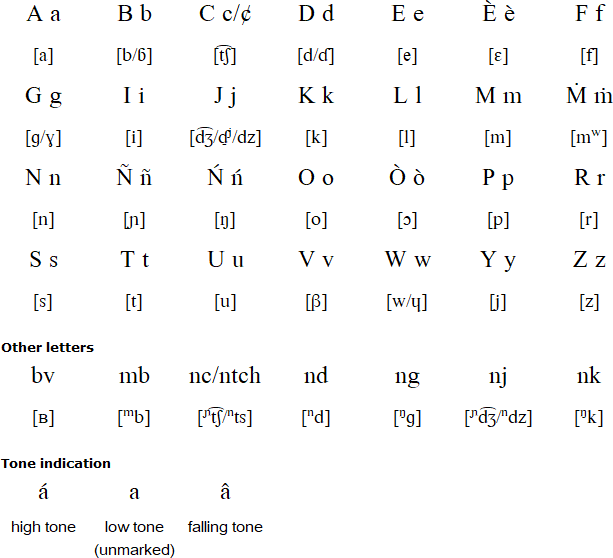Myene is a Bantu language spoken by about 46,000 people in western Gabon, particularly in the provinces of Moyen-Ogooué (Middle-Ogooue) and Ogooué-Maritime. Myene is also described as a cluster of closely-related varieties of Bantu known individually as Adyumba, Enenga, Mpongwe, Orungu, Galwa and Nkomi.
Myene was first documented in 1602 by Pieter de Marées, a Dutch trader and explorer. Since then, quite a few other people have written about the language. An orthography was devised by André Raponda Walker (1871-1968), a Gabonese author, ethnography, priest and missiony, who published a dictionary and grammar of the Mpongwe variety of the language in 1934. Other orthographies are available. Myene is used to some extent in the media and in education in Myene-speaking areas.

Download alphabet charts for Myene (Excel)
Details of Myene alphabet and pronunciation provided by Wolfram Siegel (PDF)
Source: Parler l'Omyènè (langue du Gabon) : phrases affirmatives et négatives au présent
Information about Myene
https://en.wikipedia.org/wiki/Myene_language
https://fr.wikipedia.org/wiki/Myènè_(langue)
https://worldschoolbooks.com/the-languages-of-gabon/
https://hub.localazy.com/en/languages/mye-myene
http://www.language-archives.org/language/mye
https://glottolog.org/resource/languoid/id/myen1241
https://inongo-ayile.com/apprendre-a-lire-et-ecrire-lomyene
Aka, Aushi, Bafaw-Balong, Bangi, Bangubangu, Basaa, Bemba, Bembe, Bena, Benga, Bhaca, Bila, Bube, Budu, Bujeba, Bukusu, Bulu, Bushong, Central Kilimanjaro, Central Teke, Chichewa, Chokwe, Chopi, Chuwabu, Comorian, Dciriku, Digo, Duala, Eton, Ewondo, Fang, Fuliiru, Fwe, Ganda/Luganda, Giryama, Gogo, Gungu, Gusii, Gwere, Gyele, Ha, Haya, Hehe, Herero, Ibinda, Idaxo-Isuxa-Tiriki, Ikizu, Ikoma, Jita, Kabwa, Kako, Kalanga, Kamba, Kanyok, Kgalagadi, Kiga, Kikuyu, Kimbundu, Kinyarwanda, Kirundi, Kisi, Kobo, Kogo, Komo, Kongo, Konjo, Koti, Kuhane, Kukuya, Kunda, Kuria, Kwambi, Kwangali, Kwasio, Lambya, Lega, Lengola, Lingala, Loma, Lomwe, Lozi, Luba-Katanga, Luchazi, Lunda, Luvale, Luyana, Makaa, Makonde, Makhuwa, Mandekan, Maore, Masaaba, Mbama, Mbere, Mbosi, Mbugu, Mbukushu, Mbunda, Mbuun, Mende, Mongo, Mpiemo, Mushungulu, Mwani, Myene, Nambya, Nande, Ndau, Ngoni, Ngwii, Njebi, Nkore, North Teke, Northern Ndebele (South Africa), Northern Ndebele (Zimbabwe), Northern Sotho, Nyamwezi, Nyakyusa, Nyemba, Nyole, Nyoro, Nyungwe, Nzadi, Oroko, OshiWambo, Pagibete, Pare, Punu, Rangi, Ronga, Safwa, Seki, Sena, Sengele, Shambala, Shona, Soga, Songe, Southern Ndebele, Southern Sotho, Suba, Sukuma, Swahili, Swati, Taita, Talinga, Tanga, Tembo, Tetela, Tonga, Tongwe, Tooro, Tshiluba, Tsonga, Tswa, Tswana, Tumbuka, Turu, Umbundu, Venda, Vili, Vwanji, Wanzi, West Teke, Xhosa, Yakam, Yansi, Yao, Yasa, Yeyi, Zigula, Zinza, Zulu
Languages written with the Latin alphabet
Page created: 28.04.25. Last modified: 28.04.25
[top]
You can support this site by Buying Me A Coffee, and if you like what you see on this page, you can use the buttons below to share it with people you know.

If you like this site and find it useful, you can support it by making a donation via PayPal or Patreon, or by contributing in other ways. Omniglot is how I make my living.
Note: all links on this site to Amazon.com, Amazon.co.uk
and Amazon.fr
are affiliate links. This means I earn a commission if you click on any of them and buy something. So by clicking on these links you can help to support this site.
[top]